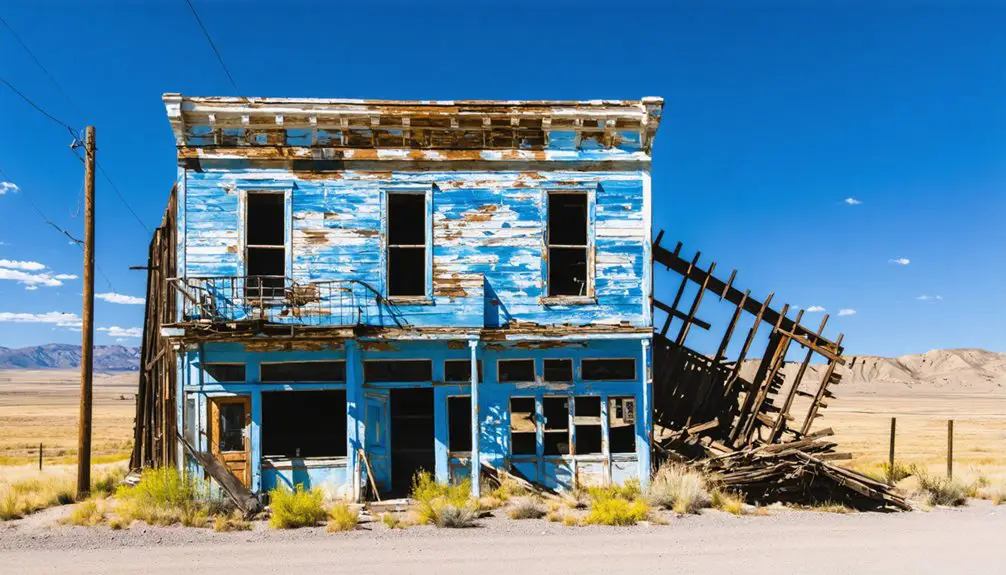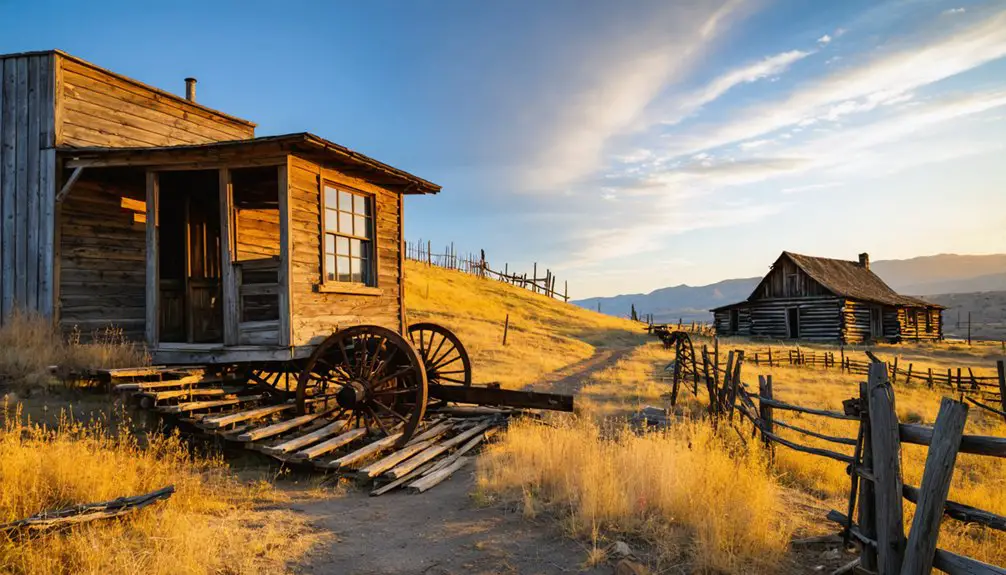You’ll find Argo ghost town in Montana’s Hellgate Mining District, where gold, silver, and copper mining once thrived in the early 1900s. Located in Broadwater County at 5,200 feet elevation, this private-land site peaked with nearly 1,000 residents before declining after 1905. The camp’s extensive tunnel system and state-of-the-art mineral processing facilities extracted 3 million pounds of copper alongside precious metals. The town’s rich history holds many more fascinating details beneath its abandoned surface.
Key Takeaways
- Argo Mine operated in Montana’s Hellgate District at 5,200 feet elevation, featuring extensive tunnels and advanced mineral processing technology.
- The ghost town peaked at 1,000 residents in the 1890s with hotels, saloons, and schools before declining dramatically by 1905.
- Gold was the primary resource, with 3 million pounds of copper and significant silver extraction supporting the mining economy.
- The site is now entirely on private land, requiring explicit landowner permission for access and lacking visitor facilities.
- Population decreased severely during World Wars I and II, dropping from 3,000 to nearly zero by the 1940s.
The Rise of Argo Mining Camp
The discovery of the Argo Mine in 1900 sparked the establishment of one of Montana’s most significant mining operations in Broadwater County’s Hellgate District.
You’ll find this historical site perched at 5,200 feet elevation, where miners once extracted valuable deposits of silver, gold, and copper.
Like its Colorado counterpart, which stretched 21,968 feet long, the Argo became known for its extensive tunnel system. Similar to the Colorado Argo, the Montana site featured state-of-the-art technology for processing the extracted minerals.
Silver, Gold, and Copper: Mining Legacy
While silver, gold, and copper formed the backbone of Argo’s mining legacy, gold emerged as the primary commodity that drove the mine’s success after its 1900 discovery.
After its discovery in 1900, gold became Argo’s driving force, though silver and copper remained vital to its legacy.
Located at 5,200 feet elevation, the mine site showcases Montana’s rich mineral deposits across its challenging mountainous terrain.
You’ll find that Argo’s underground operations extracted these precious metals from complex quartz veins throughout the Hellgate mining district, with silver extraction playing an essential role in maintaining the mining economy when gold production wavered.
The mine’s impressive output included approximately 3 million pounds of copper, alongside substantial quantities of silver and gold. The 4.16-mile rail tunnel improved ore transportation efficiency throughout the mining complex.
The operation’s sophisticated underground network of shafts and tunnels supported efficient ore recovery, though water management challenges occasionally disrupted production.
You can still trace Argo’s contribution to Montana’s mineral wealth through the region’s preserved mining heritage, marking its place among the state’s 54 significant gold-producing districts.
Life in the Hellgate Mining District
Mining operations weren’t the only force shaping life in Hell Gate Valley, as settlers first arrived in 1856 to establish permanent residences focused on timber and agriculture.
You’d find a remarkable cultural diversity here, from prospectors and traders to farmers and pack train operators, all contributing to the valley’s economic resilience. Judge Frank H. Woody and James Holt pioneered the first farms, while trading posts emerged to serve the growing community.
Like the treacherous Hell Gate strait in New York that challenged maritime navigation, the rugged Montana valley tested the resolve of its early inhabitants.
The completion of Mullan Road in 1860 transformed Hell Gate into a crucial transportation corridor, connecting Montana’s wilderness to western markets.
Despite the challenging frontier conditions and harsh winters, the community thrived through diverse income sources – from livestock raising to merchant trade – while maintaining increasingly peaceful relations with native tribes following the Hell Gate Treaty. A few Indianized Canadians managed the agricultural work using basic farming techniques, though yields remained modest.
Notable Mine Owners and Operations
During the early 1900s, two distinct Argo Mines operated under separate ownerships in Montana’s mining country – one in Broadwater County owned by Mary Ann Manger and Vincent Cope, and another in Granite County belonging to James F. McCarthy’s estate.
The Broadwater operation, headquartered in Helena, focused on extracting silver and gold through underground workings in the Hellgate District. McCarthy’s mine, managed from Wallace, Idaho, additionally pursued tungsten in the Alps District. Like other mining operations of the era that used stamp mills for processing, these mines helped drive local development. Following the pattern of successful mining towns like Virginia City, the Argo mines contributed to Montana’s territorial expansion.
Both operations reflected the individual or family-owned mining ventures typical of Montana’s post-1893 gold rush, rather than large corporate enterprises.
The mines began production around 1902, joining numerous other operations in the region that helped establish Montana’s reputation as a leading gold-producing state, despite facing the technological limitations of their era.
Peak Population and Community Development
As the mountain town of Argo reached its peak in the late 1890s, nearly 1,000 residents called this bustling Montana settlement home.
You’d find a close-knit community where miners and their families created a vibrant social scene, with weekly dances at the Union Hall and regular community events like quilting bees.
The town’s infrastructure supported strong family dynamics, featuring four hotels, eighteen saloons, and essential services including a school that educated over 40 students. Like many mining settlements, the town relied on freight wagons to transport essential supplies and ore.
You’d discover a self-sufficient community at 6,000 feet elevation, complete with a doctor’s office, butcher shop, and candy store. The Oles Saloon became a central gathering spot where residents would meet to socialize and share news.
Despite the rough-and-tumble reputation of mining towns, Argo’s small jail sat mostly empty, reflecting the family-oriented nature of this mountain settlement.
Argo defied Wild West stereotypes, its quiet jail a testament to the close community bonds of this peaceful mining town.
Unfortunately, after 1905, the population dwindled to 150 as mining fortunes faded.
Geographic Features and Location
Nestled in western Montana’s Alps Mining District, the ghost town of Argo sits at coordinates 46°34’35″N and 113°34’50″W within the rugged terrain of Granite County.
You’ll find the site surrounded by steep, forested hillsides and valleys typical of the region’s mountainous landscape, with elevations likely reaching between 3,000 to 6,000 feet above sea level.
The topographic challenges of the area include rocky slopes and seasonal water features that once served the mining operations.
While you’ll encounter accessibility issues due to the remote location, old mining roads still lead to the site.
Today’s visitors must navigate private lands and obtain necessary permissions.
The ghost town’s position amid the natural drainage patterns and cool mountain climate reflects its strategic placement for historical mining activities.
The Town’s Decline and Abandonment

While gold and silver mining thrived in Argo through the late 1890s, the town’s decline began sharply after 1900 when ore yields diminished considerably.
The economic impacts hit hard when a devastating 1912 fire destroyed half the business district, leaving essential infrastructure in ruins.
You’ll find that the social dynamics shifted dramatically during both World Wars, as miners left for wartime industries and the population plummeted from 3,000 to just a handful by the 1940s.
Modern Status and Private Land Ownership
Today, Argo ghost town sits entirely on private land, making it one of Montana’s more restricted historical sites. Unlike popular destinations such as Garnet Ghost Town, you’ll need explicit permission from the landowners for private access to explore this piece of mining history.
The site lacks the visitor facilities and guided tours you might find at other Montana ghost towns.
The private ownership creates unique preservation challenges for Argo’s remaining structures. Without public preservation programs or historical society involvement, the buildings face natural decay and potential vandalism.
While some private owners work informally with local historical groups to share knowledge, you won’t find organized restoration efforts here. Montana law requires landowner consent for entry, and you’ll need special permits for any archaeological study or artifact collection.
Frequently Asked Questions
What Happened to the Mining Equipment After Argo Was Abandoned?
You’ll find the abandoned machinery remained largely intact within Argo’s structures, as the mining equipment wasn’t salvaged after closure. It’s now preserved as historical exhibits since the 1976 site purchase.
Were There Any Major Accidents or Disasters at the Argo Mine?
Like a rushing wall of water, the only major disaster you’ll find in Argo’s mine safety records was the catastrophic 1943 flood that permanently closed operations. No accident reports show fatal incidents.
Did Argo Have a School or Church During Its Operational Years?
You won’t find historical records of formal Argo education or religion buildings. While neighboring mining towns had schools and churches, Argo’s transient population likely relied on surrounding communities for these services.
What Were the Typical Wages for Miners Working at Argo?
While exact Argo wages aren’t documented, you’d have earned between $3.00-$3.50 daily as a miner in late 1800s Montana, with labor conditions improving through union efforts to maintain these rates.
Were There Any Famous Visitors or Notable Events in Argo’s History?
You won’t find famous visitors in Argo’s records, but its most notable event was the catastrophic flood of January 19, 1943, which forced the permanent closure of the mill and tunnel.
References
- https://discoveringmontana.com/montana/ghost-towns/
- https://westernmininghistory.com/mine-detail/10105719/
- https://www.youtube.com/watch?v=lJy7Q8kNbGU
- https://www.youtube.com/watch?v=BQH5LghhkVs
- https://www.ghosttowns.com/states/mt/argo.html
- https://westernmininghistory.com/towns/colorado/idaho-springs/
- https://argomilltour.com/argo-tunnel/history/
- https://argomilltour.com/argo-tunnel/gallery/
- https://www.mindat.org/locentry-496080.html
- https://news.thediggings.com/argo-gold-mine-mill/



